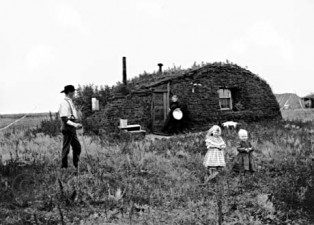It’s difficult to think of country life in the Old West without illusion. We are always tempted to invest it with virtues that appear to have been corrupted by books and movies. Folklore shamelessly exploits and intensifies images of idyllic simplicity and bedrock values. Country living presents visions of nostalgia to soothe frontier town nerves. But these visions are grossly inaccurate. Country life in the post-Civil War era was an unremitting hardship. The farmer and his family toiled fourteen hours a day merely to sustain themselves, primarily on a landscape that lacked the picturesque inspiration of Currier & Ives’ prints. Nor did their endless drudgery reward the farmers with prosperity; during the economic distress of 1870-1900 few small and middle-sized farms produced anything beyond bare subsistence, and many were foreclosed. In place of a near rose garden, an expanse of muck and manure surrounded the farmhouse, sucking at boots and exuding a pestilential stench that attracted swarms of flies, ticks and worms to amplify the miseries of man and beast. The elemental task of survival precluded any concern for hygiene or sanitary installations. And the punitive winter brought with it isolation and terrible loneliness. To the farmers a hundred plus years ago swatting insects was an impractical solution to the spring and summer invasion of flies, mosquitoes and their kin that turned the farmhouse into a buzzing, biting bedlam. In fact, there was no solution. They swarmed through the open windows of the farmhouse, alighting on food and family, massing about the stove and ceiling, blackening fruit, wallowing in milk crocks and dying in the soup. Night brought no relief as the detestable insects assembled in the bedrooms to plague the defenseless sleepers. Russel Lynes said of window screening, introduced in the 1880s, that it was “the most humane contribution the nineteenth century made to the preservation of sanity and good temper.” 
Follow Me
© 2025 Chris Enss | Privacy Policy | Design by Winter Street Design Group | Login

